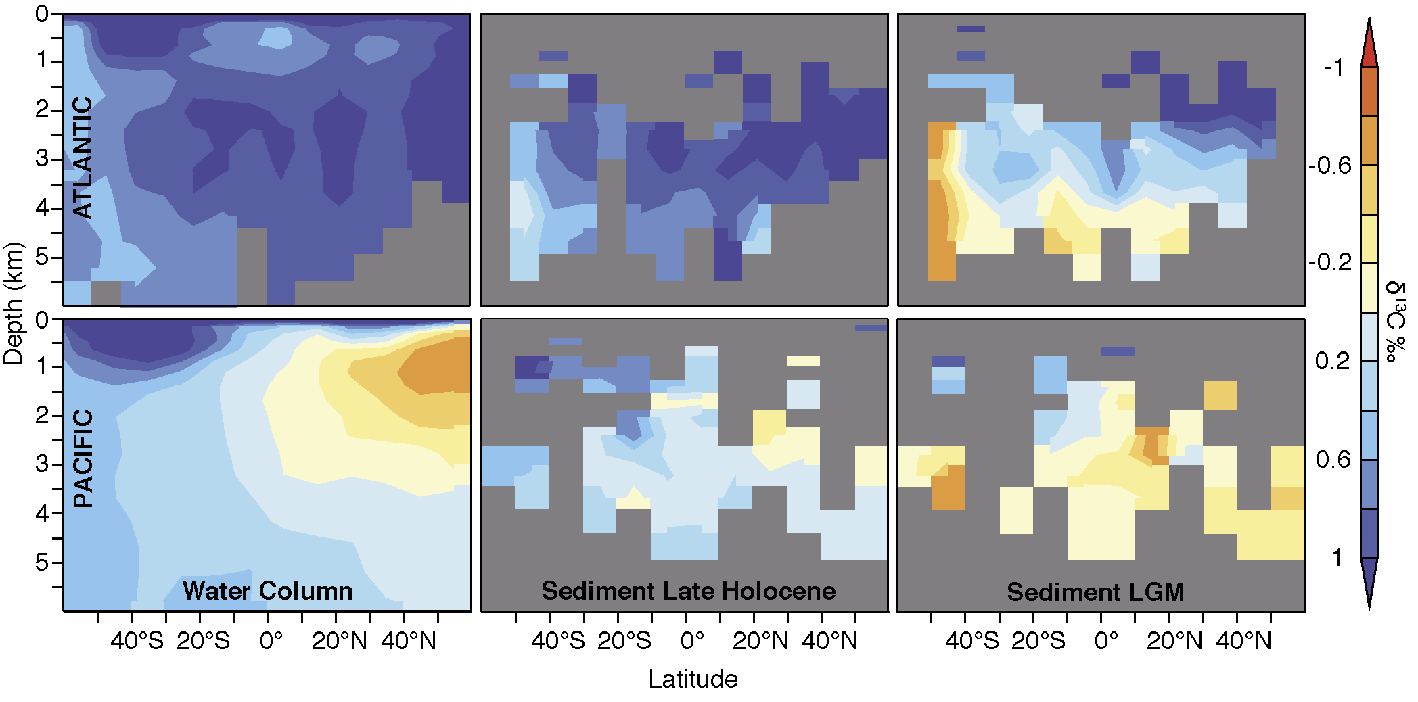- Home
- Publications
- PAGES Magazine
- Marine Nutrient Cycling - How Will The Ocean’s Capacity of Biological Carbon Pumping Change? [Past]
Marine nutrient cycling - How will the ocean’s capacity of biological carbon pumping change? [Past]
Andreas Schmittner
PAGES news
20(1)
17
2012
Andreas Schmittner
College of Oceanic and Atmospheric Sciences, Oregon State University, USA; aschmitt coas.oregonstate.edu
coas.oregonstate.edu
Changes in oceanic carbon storage have been hypothesized to be the cause of the ~100 ppm variations in atmospheric CO2 between glacials and interglacials (Sigman and Boyle 2000). If the ocean stores more carbon in colder than in warmer climates this implies that a positive feedback exists: as climate warms the ocean releases carbon, which increases atmospheric CO2 and amplifies the original warming. However, presently we don’t know how much ocean carbon storage changed in the past and why.
Carbon isotope data from Last Glacial Maximum (LGM, 19-22 ka) sediments indicate that more carbon was stored in the deepest ocean layers, particularly in the Atlantic (Fig. 1). δ13C is fractionated during carbon uptake by phytoplankton, which favors the light isotope 12C. Its distribution in the deep ocean is therefore determined to a large degree by the efficiency of the biological carbon pump, with lower values indicating more respired carbon.
In the modern ocean deep waters in the North Atlantic are high (+1‰) in δ13C and quite homogenous, corresponding to sinking of low nutrient, high oxygen surface waters. δ13C values are lower in the Southern Ocean (+0.5‰ ) and decrease towards the North Pacific (−0.6‰), reflecting today’s ocean’s oldest waters with high nutrients and carbon and low oxygen.
During the LGM, the deep Atlantic had much larger vertical gradients than today, δ13C values measured on microfossil shells of benthic foraminifera were up to 1‰ lower below 2-3 km depth, but similar above 2 km in the north (e.g. Curry and Oppo 2005). The deep Pacific Ocean was also higher in δ13C particularly in the south (Matsumoto et al. 2002). In contrast to the North Atlantic, however, the North Pacific did not exhibit larger vertical gradients. The coherent large-scale differences in δ13C suggest that biological carbon storage in the glacial ocean was most likely higher than today. But how much higher was it and why?
Biological, physical and chemical processes determine biological carbon storage in the ocean. It is likely that more than one process must be invoked to explain glacial to interglacial changes (Köhler et al. 2005). Increased solubility of CO2 in colder water explains less than 20 ppm of the full glacial-interglacial difference. The increase in the vertical gradient of δ13C in the Atlantic may require changes in the circulation such as a shoaling of the southward flowing deep waters or a change in the rate of northward flowing bottom waters. Furthermore, in a simple model of Bouttes et al. (2009) increased brine rejection from sea ice around Antarctica and its effect on deep ocean stratification lowered atmospheric CO2 by ~42 ppm, but the effect will need to be reproduced with more realistic models. Large changes in the contributions of northern versus southern sources to the global deep water can also change the efficiency of the biological pump (Martin 1990), but did not contribute much to the glacial-interglacial atmospheric CO2 changes.
The efficiency of plankton to use nitrate and phosphate may have been enhanced by more iron input to the surface ocean by higher dust deposition (Brovkin et al. 2007, estimate 37 ppm). A glacial dust plume from Patagonia may partly explain lower δ13C in South Atlantic bottom waters but the increase in aeolian iron input may have been counteracted by a decrease in sedimentary sources due to lower sea level (Moore and Braucher 2008). It is also possible that the biologically available (fixed) nitrogen inventory of the glacial ocean was overall higher than today because denitrification was lower due to higher dissolved oxygen concentrations in the colder glacial ocean and reduced continental shelf area due to the sea level drop. However, these processes have not been quantified yet with a realistic 3-dimensional model.
Some or all of the processes that controlled changes in the glacial-interglacial ocean carbon storage may also be important for our warming planet. Decreased CO2 solubility in a warming ocean will certainly occur. However, how important some of the other processes will be in the future is more uncertain. Better understanding of how and why ocean carbon storage varied in the past and in the future may now be possible due to coordinated international modeling projects and efforts to synthesize and increase the spatial coverage of paleoclimate data.
selected references
Full reference list online under: http://pastglobalchanges.org/products/newsletters/ref2012_1.pdf
Bouttes N, Roche DM and Paillard D (2009) Paleoceanography 24, doi: 10.1029/2008PA001707
Martin JH (1990) Paleoceanography 5(1): 1-13
Matsumoto K, Oba T, Lynch-Stieglitz J and Yamamoto H (2002) Quaternary Science Reviews 21: 1693-1704
